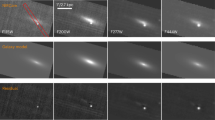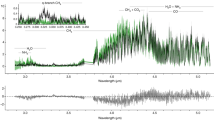Abstract
A subset of ultraluminous X-ray sources (those with luminosities of less than 1040 erg s−1; ref. 1) are thought to be powered by the accretion of gas onto black holes with masses of ∼5–20 , probably by means of an accretion disk2,3. The X-ray and radio emission are coupled in such Galactic sources; the radio emission originates in a relativistic jet thought to be launched from the innermost regions near the black hole4,5, with the most powerful emission occurring when the rate of infalling matter approaches a theoretical maximum (the Eddington limit). Only four such maximal sources are known in the Milky Way6, and the absorption of soft X-rays in the interstellar medium hinders the determination of the causal sequence of events that leads to the ejection of the jet. Here we report radio and X-ray observations of a bright new X-ray source in the nearby galaxy M 31, whose peak luminosity exceeded 1039 erg s−1. The radio luminosity is extremely high and shows variability on a timescale of tens of minutes, arguing that the source is highly compact and powered by accretion close to the Eddington limit onto a black hole of stellar mass. Continued radio and X-ray monitoring of such sources should reveal the causal relationship between the accretion flow and the powerful jet emission.
, probably by means of an accretion disk2,3. The X-ray and radio emission are coupled in such Galactic sources; the radio emission originates in a relativistic jet thought to be launched from the innermost regions near the black hole4,5, with the most powerful emission occurring when the rate of infalling matter approaches a theoretical maximum (the Eddington limit). Only four such maximal sources are known in the Milky Way6, and the absorption of soft X-rays in the interstellar medium hinders the determination of the causal sequence of events that leads to the ejection of the jet. Here we report radio and X-ray observations of a bright new X-ray source in the nearby galaxy M 31, whose peak luminosity exceeded 1039 erg s−1. The radio luminosity is extremely high and shows variability on a timescale of tens of minutes, arguing that the source is highly compact and powered by accretion close to the Eddington limit onto a black hole of stellar mass. Continued radio and X-ray monitoring of such sources should reveal the causal relationship between the accretion flow and the powerful jet emission.
This is a preview of subscription content, access via your institution
Access options
Subscribe to this journal
Receive 51 print issues and online access
$199.00 per year
only $3.90 per issue
Buy this article
- Purchase on Springer Link
- Instant access to full article PDF
Prices may be subject to local taxes which are calculated during checkout


Similar content being viewed by others
References
Walton, D., Roberts, T., Mateos, S. & Heard, V. 2XMM ultraluminous X-ray source candidates in nearby galaxies. Mon. Not. R. Astron. Soc. 416, 1844–1861 (2011)
Shakura, N. & Sunyaev, R. Black holes in binary systems. Observational appearance. Astron. Astrophys. 24, 337–355 (1973)
Middleton, M., Sutton, A., Roberts, T., Jackson, F. & Done, C. The missing link: a low-mass X-ray binary in M 31 seen as an ultraluminous X-ray source. Mon. Not. R. Astron. Soc. 420, 2969–2977 (2012)
Mirabel, I. & Rodriguez, L. A superluminal source in the Galaxy. Nature 371, 46–48 (1994)
Fender, R., Belloni, T. & Gallo, E. Towards a unified model for black hole X-ray binary jets. Mon. Not. R. Astron. Soc. 355, 1105–1118 (2004)
Grimm, H., Gilfanov, M. & Sunyaev, R. The Milky Way in X-rays for an outside observer. Log(N)–log(S) and luminosity function of X-ray binaries from RXTE/ASM data. Astron. Astrophys. 391, 923–944 (2002)
Henze, M. et al. XMMU J004243.6+412519—a new X-ray transient in M 31 seen with XMM-Newton. Astronomer’s Telegram ATel #3890, http://www.astronomerstelegram.org/?read=3890 (2012)
Monachesi, A. et al. The deepest Hubble Space Telescope color–magnitude diagram of M32. Evidence for intermediate-age populations. Astrophys. J. 727, 55 (2011)
Remillard, R. & McClintock, J. X-ray properties of black-hole binaries. Annu. Rev. Astron. Astrophys. 44, 49–92 (2006)
Dunn, R., Fender, R., Körding, E., Belloni, T. & Cabanac, C. A global spectral study of black hole X-ray binaries. Mon. Not. R. Astron. Soc. 403, 61–82 (2010)
Feng, H. & Soria, R. Ultraluminous X-ray sources in the Chandra and XMM-Newton era. N. Astron. Rev. 55, 166–183 (2011)
Kong, A., DiStefano, R., Garcia, M. & Greiner, J. Chandra studies of the X-ray point source luminosity functions of M 31. Astrophys. J. 585, 298–304 (2003)
Ueda, Y., Yamaoka, K. & Remillard, R. GRS 1915+105 in ‘soft state’: nature of accretion disk wind and origin of X-ray emission. Astrophys. J. 695, 888–899 (2009)
Abramowicz, M., Czerny, B., Lasota, J.-P. & Szuszkiewicz, E. Slim accretion disks. Astrophys. J. 332, 646–658 (1988)
Middleton, M., Sutton, A. & Roberts, T. X-ray spectral evolution in the ultraluminous X-ray source M33 X-8. Mon. Not. R. Astron. Soc. 417, 464–471 (2011)
King, A. Masses, beaming and Eddington ratios in ultraluminous X-ray sources. Mon. Not. R. Astron. Soc. 393, L41–L44 (2009)
Feng, H. & Kaaret, P. Spectral states and evolution of ultraluminous X-ray sources. Astrophys. J. 696, 1712–1726 (2009)
Cseh, D. et al. Black hole powered nebulae and a case study of the ultraluminous X-ray source IC 342 X-1. Astrophys. J. 749, 17 (2012)
Merloni, A., Heinz, S. & di Matteo, T. A fundamental plane of black hole activity. Mon. Not. R. Astron. Soc. 345, 1057–1076 (2003)
Plotkin, R., Markoff, S., Kelly, B., Körding, E. & Anderson, S. Using the fundamental plane of black hole activity to distinguish X-ray processes from weakly accreting black holes. Mon. Not. R. Astron. Soc. 419, 267–286 (2012)
Gallo, E., Fender, R. & Pooley, G. A universal radio-X-ray correlation in low/hard state black hole binaries. Mon. Not. R. Astron. Soc. 344, 60–72 (2003)
Kaiser, C., Sunyaev, R. & Spruit, H. Internal shock model for microquasars. Astron. Astrophys. 356, 975–988 (2000)
King, A. The brightest black holes. Mon. Not. R. Astron. Soc. 335, L13–L16 (2002)
Fender, R. & Belloni, T. GRS 1915+105 and the disc–jet coupling in accreting black hole systems. Annu. Rev. Astron. Astrophys. 42, 317–364 (2004)
Pooley, G. & Fender, R. The variable radio emission from GRS 1915+105. Mon. Not. R. Astron. Soc. 292, 925–933 (1997)
Corbel, S. et al. A giant radio flare from Cygnus X-3 with associated γ-ray emission. Mon. Not. R. Astron. Soc. 421, 2947–2955 (2012)
Orosz, J. A. et al. A black hole in the superluminal source SAX J1819.3−2525 (V4641 Sgr). Astrophys. J. 555, 489–503 (2001)
Hjellming, R. M. et al. Light curves and radio structure of the 1999 September transient event in V4641 Sagittarii ( = XTE J1819–254 = SAX J1819.3–2525). Astrophys. J. 544, 977–992 (2000)
Vilardell, F., Ribas, I. & Jordi, C. Eclipsing binaries suitable for distance determination in the Andromeda galaxy. Astron. Astrophys. 459, 321–331 (2006)
Soria, R. et al. The birth of an ultraluminous X-ray source in M83. Astrophys. J. 750, 152 (2012)
Acknowledgements
We thank C. Trott and R. Soria for discussions, and C. Gough for making his code available. This work was supported by a Science and Technology Facilities Council (STFC) standard grant (M.J.M.), Netherlands Organization for Scientific Research Vidi Fellowship (S.M.), European Research Council partial funding (R.F.) and grant number BMWI/DLR, FKZ 50 OR 1010 (M. Henze). The National Radio Astronomy Observatory is a facility of the National Science Foundation operated under cooperative agreement by Associated Universities, Inc. We thank the staff of the Mullard Radio Astronomy Observatory for their assistance in the commissioning and operation of AMI, which is supported by Cambridge University and the STFC. This work is based on observations obtained with XMM-Newton, an ESA science mission with instruments and contributions directly funded by ESA Member States and NASA. This research has also made use of data obtained from NASA’s Swift and Chandra satellites.
Author information
Authors and Affiliations
Contributions
M.J.M. wrote the manuscript with comments from all authors. J.C.A.M.-J. designed and analysed the VLA and VLBA observations. N.H.-W. and A.M.M.S. analysed the AMI-LA observations. J.-P.M. and J.C.A.M.-J. conducted the scintillation analysis. S.M., R.F. and M. Henze made significant contributions to the overall science case and manuscript. J.C., G.C.B. and M.G. provided support and analysis for the CARMA observations. The remaining authors either assisted with various aspects of the science case or are contributing members of the M 31 group.
Corresponding author
Ethics declarations
Competing interests
The authors declare no competing financial interests.
Supplementary information
Supplementary Information
This file contains Supplementary Methods, Supplementary References, Supplementary Tables 1-3 and Supplementary Figures 1-2. (PDF 412 kb)
PowerPoint slides
Rights and permissions
About this article
Cite this article
Middleton, M., Miller-Jones, J., Markoff, S. et al. Bright radio emission from an ultraluminous stellar-mass microquasar in M 31. Nature 493, 187–190 (2013). https://doi.org/10.1038/nature11697
Received:
Accepted:
Published:
Issue Date:
DOI: https://doi.org/10.1038/nature11697
This article is cited by
-
Study of the ultraluminous X-ray sources in NGC 4382 and NGC 1399 with Chandra
Indian Journal of Physics (2024)
-
Correction to: X-Ray Properties of TDEs
Space Science Reviews (2021)
-
X-Ray Properties of TDEs
Space Science Reviews (2020)
-
A likely decade-long sustained tidal disruption event
Nature Astronomy (2017)
-
Study of X-ray point sources in NGC 5643 and NGC 7457 with Chandra
Astrophysics and Space Science (2017)
Comments
By submitting a comment you agree to abide by our Terms and Community Guidelines. If you find something abusive or that does not comply with our terms or guidelines please flag it as inappropriate.



